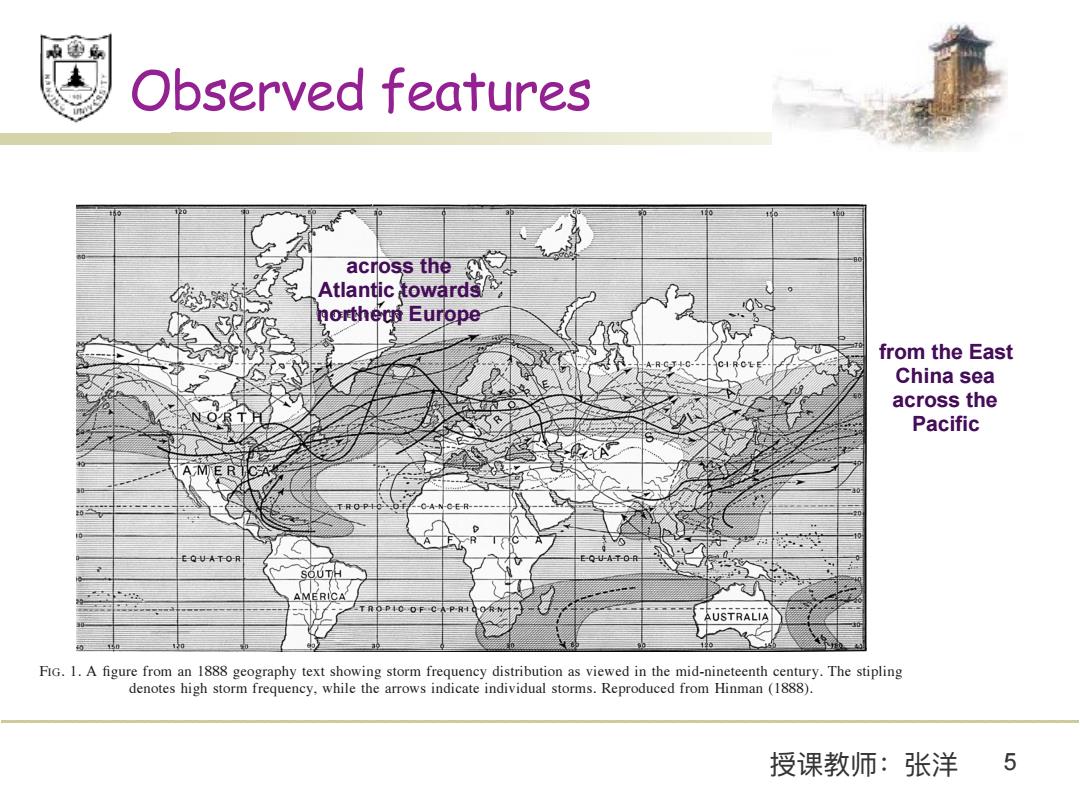正在加载图片...

Observed features across the Atlantic towards/ northern Europe from the East China sea across the Pacific EQAT0R SOUTH +" TROPIO OF CA AUSTRALIA FIG.1.A figure from an 1888 geography text showing storm frequency distribution as viewed in the mid-nineteenth century.The stipling denotes high storm frequency,while the arrows indicate individual storms.Reproduced from Hinman(1888). 授课教师:张洋5授课教师:张洋 5 Observed features 2164 JOURNAL OF CLIMATE VOLUME 15 FIG. 1. A figure from an 1888 geography text showing storm frequency distribution as viewed in the mid-nineteenth century. The stipling denotes high storm frequency, while the arrows indicate individual storms. Reproduced from Hinman (1888). er activity over central Asia; and a third weak maxima in cyclone activity located over the Mediterranean, extending into central Asia. Consistent with the eastward propagation of disturbances, cyclogenesis preferentially occurs on the westward fringe of the areas of maximum cyclone occurrence. The advent of gridded atmospheric analyses at regular time intervals in the late 1970s heralded a new and dynamically more complete picture of storm track structure. Blackmon (1976) and Blackmon et al. (1977), following a methodology that can be traced to Klein (1951), showed that the atmosphere is described by a dispersion relation of sorts, as time filtering a series of gridded analyses maps to isolate disturbances with periods of 2–7 days (see also Hartmann 1974; Randel and Stanford 1985) isolates the O(1000 km) spatial-scale mobile transients familiar from the above synoptic classification of storm tracks. Further, this ‘‘bandpass’’ filtering has the distinct advantage vis-a´-vis synoptic classification that it can be carried out at all levels in the atmosphere, allowing the development of a true threedimensional picture of storm tracks. The original diagnoses of Blackmon and collaborators, along with numerous others since, provide an alternative definition of storm tracks as geographically localized maxima in bandpass transient variance. Examples of storm track structure that emerge from such an analysis are shown in Figs. 2a–c, where the storm tracks are marked in the various bandpass standard deviation fields by enhanced variability off the east coasts of Asia and North America, more or less coinciding with the regions of maximum cyclone occurrence described above. With their strong connection to sensible weather, storm tracks play a prominent part in midlatitude climate dynamics. Regardless of how one chooses to define storm tracks, a systematic shift in either their geographical location or the level of storm activity will lead to substantial precipitation anomalies with consequent impacts on regional climates. A particularly pointed example of precipitation anomalies resulting from a change in storm track structure occurs during strong El Nin˜o events, when the Pacific storm track extends much farther downstream than it does during ‘‘normal’’ winters. This downstream extension brings more active landfalling cyclones to California, resulting in flooding, landslides, and beach erosion. However, it is not only the ‘‘obvious’’ changes in precipitation patterns associated with shifts in storm track structure that explains why storm tracks are a topic of such vital importance to climate dynamics. Rather, over the past decade there has been a growing realization that storm tracks are symbiotically linked (following the terminology of Cai and Mak 1990) to the planetaryscale flow. To be concrete, consider a common problem in climate dynamics; namely, diagnosing an anomaly in the planetary-scale flow associated with some imposed external forcing, that is, anomalous tropical heating associated with El Nin˜o SST anomalies. In general, a corresponding shift in the storm track structure will accompany the anomaly in the planetary-scale flow (Branstator 1995). However, diagnoses have shown that the storm track shift, through anomalous fluxes of heat and momentum, often forces a larger component of the observed planetary-scale flow anomaly than the imposed from the East China sea across the Pacific across the Atlantic towards northern Europe